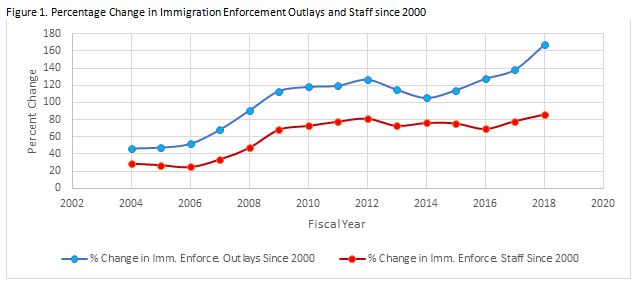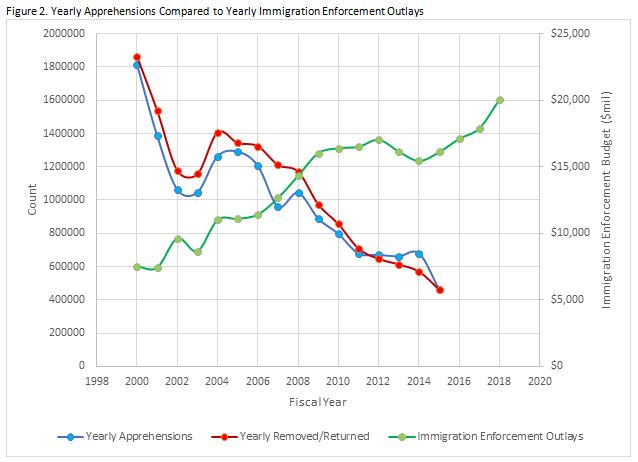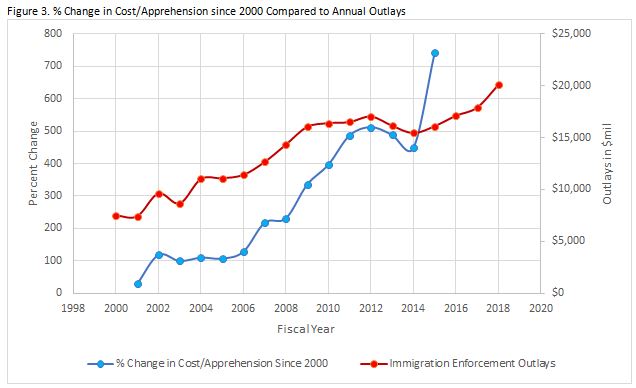Jacob Yarborough
During the 2016 election cycle, then-candidate Trump’s call for strict immigration reform was a mainstay of his presidential campaign. It is then no surprise that now-President Trump has proposed increased funding for regulators who focus on border security and immigration enforcement.
The 2018 Regulators’ Budget report, a joint study between the GW Regulatory Studies Center and the Weidenbaum Center at Washington University in St. Louis, found the president’s budget includes proposed real increases in expenditures of 9.9% to Customs and Border Protection (CBP) and 17.5% to Immigration and Customs Enforcement (ICE). This would expand their budgets to $15.9 billion and $7.3 billion respectively. The proposed 11.7% hike in homeland security spending is almost three times as much as the estimated 4.1% increase for the same agencies in 2017. These increases in real expenditures and staffing have come during a period of declining illegal alien apprehensions and removals/returns, where “apprehensions” are a combined total of CBP and ICE apprehensions and “removal/returns” are compulsory and confirmed movement of an inadmissible or deportable alien out of the United States. From 2000 to 2015 the number of yearly apprehensions declined by 74.5% and the number of yearly removals/returns declined by 75.2%.
The surge in immigration enforcement and border patrol spending makes up a significant portion of the 4% increase in the expenditures for social regulations. Economic regulations are projected to receive a proposed increase of 1% in 2018. These upticks combine for a proposed real increase of 3.4% in expenditures for regulatory departments and agencies overall, which amounts to approximately $69.4 billion. The requested step-up of 3.4% for 2018 is twice as much as the estimated appropriated increase in the 2017 budget over 2016, which was 1.7%.
The 2018 regulators’ budget continues a long-term trend of increased spending on immigration enforcement, as illustrated by the combined total expenditures of CBP and ICE. From 2000 to 2017 real expenditures for immigration enforcement grew by 138%, while staffing for immigration enforcement rose by 78%. As shown in Figure 1 below, the proposed expansions for 2018 would represent a 167% real increase in expenditures for immigration enforcement over 2000 levels and an 86% increase in staffing levels.

During the period of declining apprehensions of illegal aliens, real expenditures for immigration enforcement increased by 114% and staffing for immigration enforcement increased 75.6%, compared to 2000 levels. Figure 2 below shows the reduction in yearly apprehensions and removals/returns compared to the real increase in immigration enforcement expenditures, including the proposed boost for 2018.

At a time when swelling expenditures and declining illegal alien apprehensions are occurring, the cost per apprehension has risen dramatically. From 2000 to 2015 the cost per apprehension ballooned by 740%. Figure 3 below shows the percentage change in cost per apprehension over 2000 levels, compared to the real budget for immigration enforcement.

As the previous tables show, while there has been an overall expansion in expenditures and staff levels for immigration enforcement since 2000, there has not been a similar increase in the amount of apprehensions or removals/returns. In fact, the opposite is true. While the budget and staff at CBP and ICE have increased over the last 17 years, the amount of apprehensions and removals/returns has decreased. It does not seem that inflating the budget or staff of these agencies has allowed them to become more efficient in apprehending and removing illegal aliens. This is evidenced by the rise in cost per apprehension in Figure 3 and the overall downturn in apprehensions in Figure 2.
Reports indicate that for the current year of 2017, attempted border crossings have already been reduced to a 17-year low, which has occurred without the proposed hike in outlays. As Department of Homeland Security spokesman David Lapan said to CNN, this could be due to the current Administration’s strong language and stance regarding immigration. It’s possible that the overall tone regarding immigration enforcement and shifting priorities has had more of an affect than the rise in outlays and staffing levels, however there are other variables that could contribute to the decrease in border apprehensions. The continual increase in expenditures and staffing for immigration enforcement between the years of 2000 to 2015 have not been tied to any increase in the amount of apprehensions or decrease in cost per apprehension of illegal aliens over the same time-period. This seems to indicate that policies of continual budgetary expansion could be replaced with evidenced-based appropriations that analyze current trends and data for a more cost-effective approach.

